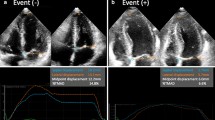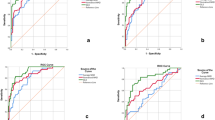Abstract
Background
Left ventricular global longitudinal strain (LVGLS) has prognostic value for adverse cardiac events. Application of speckle-tracking technology to mitral annulus provides easy assessment of tissue-tracking mitral annular displacement (TMAD) in apical four-chamber view. The study aimed to examine whether TMAD can be used as a simple index of LV longitudinal deformation in patients with and without preserved ejection fraction (EF).
Methods
The study population consisted of 95 consecutive subjects. GLS was assessed from three apical views. TMAD was evaluated as the base-to-apex displacement of septal (TMADsep), lateral (TMADlat), and mid-point of annular line (TMADmid) in apical 4-chamber view. The percentage of TMADmid to LV length from the mid-point of mitral annuls to the apex at end-diastole (%TMADmid) was calculated. We compared each TMAD parameter with GLS by linear regression analysis, and analyzed each TMAD parameter by receiver operating characteristic (ROC) curve to detect impaired LV longitudinal deformation (|GLS|< 15.0%).
Results
There were good correlations between each TMAD parameter and GLS (TMADsep: r2 = 0.59, p < 0.01. TMADlat: r2 = 0.65, p < 0.01. TMADmid: r2 = 0.68, p < 0.01. %TMADmid: r2 = 0.75, p < 0.01). According to ROC curve, %TMADmid < 10.5% was the best cut-off value in determining impaired LV longitudinal deformation (|GLS|≤ 15.0%) with a sensitivity of 95% and a specificity of 93%. The area under the curve (AUC) of %TMADmid was 0.98 (95% confidence intervals (CI) 0.93–0.99).
Conclusions
TMAD using speckle-tracking echocardiography quickly estimated from single apical four-chamber view can be used as a simple index for detection of impaired LV longitudinal deformation in patients with and without preserved EF.






Similar content being viewed by others
Abbreviations
- TMAD:
-
Tissue-tracking mitral annular displacement
References
Kearney LG, Lu K, Ord M, et al. Global longitudinal strain is a strong independent predictor of all-cause mortality in patients with aortic stenosis. Eur Heart J Cardiovasc Imaging. 2012;13:827.
Kraigher-Krainer E, Shah AM, Gupta DK, et al. Impaired systolic function by strain imaging in heart failure with preserved ejection fraction. J Am Coll Cardiol. 2014;63:447–56.
Russo C, Jin Z, Elkind MS, et al. Prevalence and prognostic value of subclinical left ventricular systolic dysfunction by global longitudinal strain in a community-based cohort. Eur J Heart Fail. 2014;16:1301–9.
Kadappu KK, Thomas L. Tissue doppler imaging in echocardiography: value and limitations. Heart Lung Circ. 2015;24:224–33.
Carlhäll C, Wigström L, Heiberg E, et al. Contribution of mitral annular excursion and shape dynamics to total left ventricular volume change. Am J Physiol Heart Circ Physiol. 2004;287:H1836–41.
Tsang W, Ahmad H, Patel AR, et al. Rapid estimation of left ventricular function using echocardiographic speckle-tracking of mitral annular displacement. J Am Soc Echocardiogr. 2010;23:511.
Buss SJ, Mereles D, Emami M, et al. Rapid assessment of longitudinal systolic left ventricular function using speckle tracking of the mitral annulus. Clin Res Cardiol. 2012;101:273.
Suzuki K, Akashi YJ, Mizukoshi K, et al. Relationship between left ventricular ejection fraction and mitral annular displacement derived by speckle tracking echocardiography in patients with different heart diseases. J Cardiol. 2012;60:55–60.
Teraguchi I, Hozumi T, Takemoto K, et al. Assessment of impaired left ventricular longitudinal deformation in asymptomatic patients with organic mitral regurgitation and preserved ejection fraction using tissue-tracking mitral annular displacement by speckle-tracking echocardiography. Echocardiography. 2019;36:678–86.
Lang RM, Badano LP, Mor-Avi V, et al. Recommendations for cardiac chamber quantification by echocardiography in adults: an update from the American Society of Echocardiography and the European Association of Cardiovascular Imaging. J Am Soc Echocardiogr. 2015;28:1-39.e14.
Chiu DY, Abidin N, Hughes J, et al. Speckle tracking determination of mitral tissue annular displacement: comparison with strain and ejection fraction, and association with outcomes in haemodialysis patients. Int J Cardiovasc Imaging. 2016;32:1511–8.
Gjesdal O, Vartdal T, Hopp E, et al. Left ventricle longitudinal deformation assessment by mitral annulus displacement or global longitudinal strain in chronic ischemic heart disease: are they interchangeable? J Am Soc Echocardiogr. 2009;22:823–30.
Zamorano JL, Lancellotti P, Rodriguez Muñoz D, et al. 2016 ESC Position Paper on cancer treatments and cardiovascular toxicity developed under the auspices of the ESC Committee for Practice Guidelines: the Task Force for cancer treatments and cardiovascular toxicity of the European Society of Cardiology (ESC). Eur Heart J. 2016;37:2768–801.
Plana JC, Galderisi M, Barac A, et al. Expert consensus for multimodality imaging evaluation of adult patients during and after cancer therapy: a report from the American Society of Echocardiography and the European Association of Cardiovascular Imaging. J Am Soc Echocardiogr. 2014;27:911–39.
Gökdeniz T, Boyaci F, Hatem E, et al. Association of mitral annular calcification with left ventricular mechanics: a speckle tracking study. Echocardiography. 2015;32:1374–83.
Acknowledgements
None
Funding
None.
Author information
Authors and Affiliations
Corresponding author
Ethics declarations
Conflict of interest
Kosei Terada, Takeshi Hozumi, Suwako Fujita, Kazushi Takemoto, Takahiro Nishi, Amir Kh. M. Khalifa, Takashi Kubo, Atsushi Tanaka, Takashi Akasaka declare that they have no conflict of interest.
Human rights statements
All procedures followed were in accordance with the ethical standards of the responsible committee on human experimentation (institutional and national) and with the Helsinki Declaration of 1964 and later versions.
Informed consent
Informed consent was obtained from all patients for being included in the study.
Additional information
Publisher's Note
Springer Nature remains neutral with regard to jurisdictional claims in published maps and institutional affiliations.
Rights and permissions
About this article
Cite this article
Terada, K., Hozumi, T., Fujita, S. et al. Feasibility of tissue-tracking mitral annular displacement in single four-chamber view as a simple index of left ventricular longitudinal deformation. J Echocardiogr 20, 224–232 (2022). https://doi.org/10.1007/s12574-022-00578-5
Received:
Revised:
Accepted:
Published:
Issue Date:
DOI: https://doi.org/10.1007/s12574-022-00578-5




